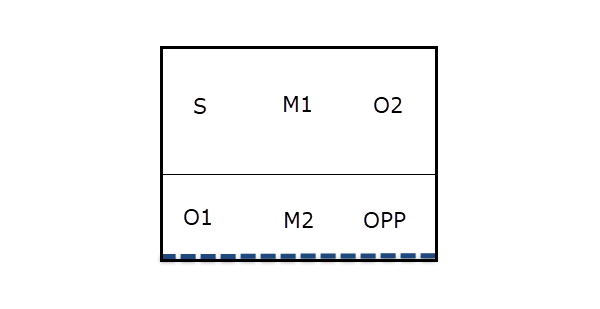How should I set my line-up?
I’ve addressed this in broad strokes in the Putting together a starting line-up post. Here, though, I want to drill down. I’m going to look specifically at how you place the players on the court by position.
Here’s the most common way teams line-up when playing a 5-1 system.

Let me explain the abbreviations.
S = Setter
M1 = Stronger Middle
M2 = Weaker Middle
O1 = Stronger Outside Hitter
O2 = Weaker Outside Hitter
OPP = Opposite
So, if someone (like me) talks about their O2 or M1, you know they are referring to positions relative to the setter. The 1’s are next to the setter.
Note: The fact that the setter in the diagram is in Position 1 isn’t meant to suggest that’s the best place to start them. There are a number of factors which figure in to whether you start there or in a different rotation.
Balance
The basic idea with the ordering of the player positions this way is balance. That’s how the above diagram came to be. The better middle is next to the setter and the weaker outside. Likewise, the stronger outside is also next to the setter as well as the weaker middle. Further, when the O2 and M2 are both in the front row, the opposite is also in the front row, providing three attackers, rather than just two.
Now, how you judge your stronger/weaker middles and outside hitters can vary. The initial thought may be balancing things offensively, but it doesn’t have to be that way. For example, if your setter is not a good blocker, you may put your better blocking middle at M1 to create more balance from that perspective.If your middles have similar attacking abilities, then looking at their blocking can be very useful.
Serve reception is another way you may try to balance things. I once saw a coaching friend of mine put his strongest outside hitter at O2 rather than O1. When I asked him why he told me it was about passing. In his system the O1 passed in the middle of the formation more often than the O2, but his stronger attacker was not his strongest passer. Moving him to O2 reduced his exposure in serve receive, helping to balance things out in that way.
Middle leads, or outside leads?
You will notice in the formation above that the M1 leads the setter in the rotation. We refer to this as a “middle leads” arrangement. Though it’s not as frequently seen, some teams do use an “outside leads” set-up.
Why is the middle leads system generally favored?
It comes down to serve receive. The system where the outside leads can create some awkward reception formations, and fewer options. The middle leads approach tends to offer more flexibility.
The above, though, assumes you’re mainly using your outsides and libero to pass. Most teams do this, of course, but you may find yourself in a situation where you can pull someone else in to pass. Maybe your opposite is a good passer, or even one of your middles. In that case, you may find it better to use an outside leads approach.
I definitely recommend that you take some time to write out each of your rotations. Map out a primary reception pattern and also look at alternatives. If nothing else, it’s good to know your options if you need to change things up. Make sure you know how the overlap rules work and how they can actually be used.